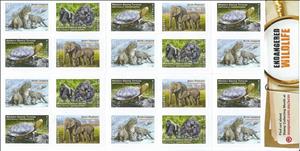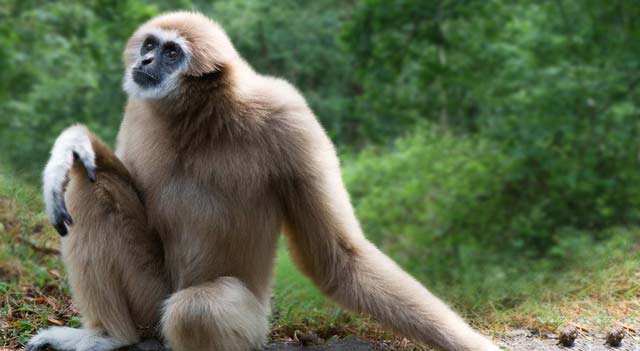Booklet: Endangered Wildlife (Australia 2016)
Endangered Wildlife (Australia 2016)
20 September (Australia ) within release Endangered Wildlife goes into circulation Booklet Endangered Wildlife face value 20*1 Australian dollar
| Booklet Endangered Wildlife in catalogues | |
|---|---|
| Michel: | Mi: AU MH710 |
| Stamp Number: | Sn: AU 4547b |
| Yvert et Tellier: | Yt: AU C4380 |
Booklet is square format.
Booklet pane of 20Also in the issue Endangered Wildlife:
- Souvenir Sheet - Endangered Wildlife Souvenir Sheet face value 6;
- Stamp - Southern Corroboree Frog (Pseudophryne corroboree) face value 1;
- Stamp - Snow Leopard (Panthera uncia syn. Uncia uncia) face value 1;
- Stamp - Snow Leopard (Panthera uncia syn. Uncia uncia) face value 1;
- Stamp - Asian Elephant (Elephas maximus) face value 1;
- Stamp - Asian Elephant (Elephas maximus) face value 1;
- Stamp - Western Lowland Gorilla (Gorilla gorilla gorilla) face value 1;
- Stamp - Western Lowland Gorilla (Gorilla gorilla gorilla) face value 1;
- Stamp - Western Swamp Tortoise (Pseudemydura umbrina) face value 1;
- Stamp - Western Swamp Tortoise (Pseudemydura umbrina) face value 1;
- Stamp - Orange-bellied Parrot (Neophema chrysogaster) face value 50;
- Stamp - Northern Quoll (Dasyurus hallucatus) face value 50;
- Se-tenant - Endangered Wildlife face value 4*1;
- Se-tenant - Endangered Wildlife face value 2*50;
- Booklet - Endangered Wildlife face value 20*1;
- Stamp - Asian Elephant (Elephas maximus) face value 1;
- Stamp - Western Lowland Gorilla (Gorilla gorilla gorilla) face value 1;
- Stamp - Snow Leopard (Panthera uncia syn. Uncia uncia) face value 1;
- Stamp - Western Swamp Tortoise (Pseudemydura umbrina) face value 1;
Booklet Endangered Wildlife it reflects the thematic directions:
Animals are multicellular, eukaryotic organisms of the kingdom Animalia (also called Metazoa). All animals are motile, meaning they can move spontaneously and independently, at some point in their lives. Their body plan eventually becomes fixed as they develop, although some undergo a process of metamorphosis later on in their lives. All animals are heterotrophs: they must ingest other organisms or their products for sustenance.
Apes (collectively Hominoidea /hɒmɪˈnɔɪdi.ə/) are a clade of Old World simians native to sub-Saharan Africa and Southeast Asia (though they were more widespread in Africa, most of Asia, and Europe in prehistory), which together with its sister group Cercopithecidae form the catarrhine clade, cladistically making them monkeys. Apes do not have tails due to a mutation of the TBXT gene. In traditional and non-scientific use, the term ape can include tailless primates taxonomically considered Cercopithecidae (such as the Barbary ape and black ape), and is thus not equivalent to the scientific taxon Hominoidea. There are two extant branches of the superfamily Hominoidea: the gibbons, or lesser apes; and the hominids, or great apes.
The fishing cat (Prionailurus viverrinus) is a medium-sized wild cat of South and Southeast Asia. It has a deep yellowish-grey fur with black lines and spots. Adults have a head-to-body length of 57 to 78 cm (22 to 31 in), with a 20 to 30 cm (7.9 to 11.8 in) long tail. Males are larger than females weighing 8 to 17 kg (18 to 37 lb); females average 5 to 9 kg (11 to 20 lb). Since 2016, it is listed as Vulnerable on the IUCN Red List. Fishing cat populations are threatened by destruction of wetlands and have declined severely over the last decade. The fishing cat lives foremost in the vicinity of wetlands, along rivers, streams, oxbow lakes, in swamps, and mangroves.
Elephants are the largest living land animals. Three living species are currently recognised: the African bush elephant (Loxodonta africana), the African forest elephant (L. cyclotis), and the Asian elephant (Elephas maximus). They are the only surviving members of the family Elephantidae and the order Proboscidea; extinct relatives include mammoths and mastodons.
Mammals are any vertebrates within the class Mammalia (/məˈmeɪli.ə/ from Latin mamma "breast"), a clade of endothermic amniotes distinguished from reptiles (including birds) by the possession of a neocortex (a region of the brain), hair, three middle ear bones and mammary glands. All female mammals nurse their young with milk, secreted from the mammary glands. Mammals include the largest animals on the planet, the great whales. The basic body type is a terrestrial quadruped, but some mammals are adapted for life at sea, in the air, in trees, underground or on two legs. The largest group of mammals, the placentals, have a placenta, which enables the feeding of the fetus during gestation. Mammals range in size from the 30–40 mm (1.2–1.6 in) bumblebee bat to the 30-meter (98 ft) blue whale. With the exception of the five species of monotreme (egg-laying mammals), all modern mammals give birth to live young. Most mammals, including the six most species-rich orders, belong to the placental group. The largest orders are the rodents, bats and Soricomorpha (shrews and allies). The next three biggest orders, depending on the biological classification scheme used, are the Primates (apes and monkeys), the Cetartiodactyla (whales and even-toed ungulates), and the Carnivora (cats, dogs, seals, and allies).
Reptiles are tetrapod (four-limbed vertebrate) animals in the class Reptilia, comprising today's turtles, crocodilians, snakes, amphisbaenians, lizards, tuatara, and their extinct relatives. The study of these traditional reptile orders, historically combined with that of modern amphibians, is called herpetology. Because some reptiles are more closely related to birds than they are to other reptiles (e.g., crocodiles are more closely related to birds than they are to lizards), the traditional groups of "reptiles" listed above do not together constitute a monophyletic grouping (or clade). For this reason, many modern scientists prefer to consider the birds part of Reptilia as well, thereby making Reptilia a monophyletic class.
Turtles are reptiles of the order Testudines, characterized by a special shell developed mainly from their ribs. Modern turtles are divided into two major groups, the Pleurodira (side necked turtles) and Cryptodira (hidden necked turtles), which differ in the way the head retracts. There are 360 living and recently extinct species of turtles, including land-dwelling tortoises and freshwater terrapins. They are found on most continents, some islands and, in the case of sea turtles, much of the ocean. Like other amniotes (reptiles, birds, and mammals) they breathe air and do not lay eggs underwater, although many species live in or around water.







